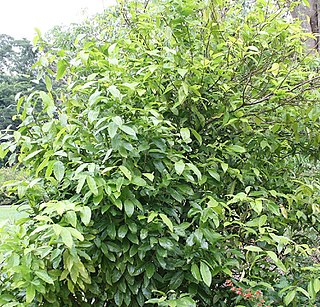Heliciopsis is a genus of about fourteen species of trees, constituting part of the flowering plant family Proteaceae. They grow naturally in Myanmar, Indo-China, China, Thailand, Peninsular Malaysia, Borneo, Sumatra, Java (Indonesia) and the Philippines. The name means similar to the plant genus Helicia. Its closest relatives are Athertonia (Australia) and Virotia.
Rauvolfia sumatrana is a tree in the family Apocynaceae.
Dipterocarpus kunstleri is a species of tree in the family Dipterocarpaceae, native to Southeast Asia.

Symplocos anomala is a plant in the family Symplocaceae.
Gonystylus maingayi is a tree in the family Thymelaeaceae.

Phaleria perrottetiana is a plant in the family Thymelaeaceae.
Ligustrum glomeratum is a plant in the family Oleaceae. The specific epithet glomeratum means 'gathered closely', referring to the flowers.
Helicia excelsa is a plant in the family Proteaceae. It grows as a tree up to 20 metres (70 ft) tall, with a trunk diameter of up to 25 centimetres (10 in). The bark is dark grey to blackish. Inflorescences bear up to three reddish brown flowers. Fruit is black, ellipsoid, up to 3 centimetres (1 in) long. The specific epithet excelsa is from the Latin meaning 'lofty', referring to the tree's growth. Habitat is forests from sea level to 1,700 metres (5,600 ft) altitude. H. excelsa is found in Bangladesh, Burma, Thailand, Malaysia and Indonesia.
Helicia fuscotomentosa is a plant in the family Proteaceae. It grows as a tree up to 25 metres (80 ft) tall, with a trunk diameter of up to 30 centimetres (12 in). The bark is mottled grey and black. The flowers are reddish brown. Its habitat is forests from sea level to 2,000 metres (6,600 ft) altitude. H. fuscotomentosa is endemic to Borneo.
Helicia maxwelliana is a plant in the family Proteaceae. It is named for D. R. Maxwell, who accompanied botanist Lilian Gibbs on her 1910 Mount Kinabalu expedition, where she recorded numerous new plant species.
Helicia petiolaris is a plant in the family Proteaceae. The specific epithet petiolaris means 'stalked', referring to the leaves.
Helicia pterygota is a plant in the family Proteaceae. The specific epithet pterygota means 'winged', referring to the pedicel.
Madhuca dubardii is a plant in the family Sapotaceae.
Diospyros borneensis is a tree in the family Ebenaceae. It grows up to 20 metres (70 ft) tall. Twigs are reddish brown when young, drying black. Inflorescences bear up to 20 flowers. The fruits are round, drying black, up to 4.2 cm (2 in) in diameter. The tree is named for Borneo. Habitat is forests from sea-level to 1,000 metres (3,300 ft) altitude. D. borneensis is found in Peninsular Thailand, Sumatra, Peninsular Malaysia and Borneo.

Diospyros maritima is a tree in the family Ebenaceae. The specific epithet maritima means 'by the sea', referring to the tree's habitat.
Symplocos ophirensis is a tree in the family Symplocaceae, native to tropical Asia. It is named for Mount Ophir in Peninsular Malaysia.
Symplocos crassipes is a plant in the family Symplocaceae, native to Southeast Asia. The specific epithet crassipes means 'thick foot', referring to the stem.
Helicia symplocoides is a tree in the family Proteaceae, native to Borneo. The specific epithet symplocoides refers to the leaves' resemblance to those of the genus Symplocos.
Helicia rufescens is a tree in the family Proteaceae, native to Southeast Asia. The specific epithet rufescens means 'becoming reddish', referring to the indumentum of the inflorescences, twigs and leaves.
Helicia sessilifolia is a tree in the family Proteaceae, native to Borneo. The specific epithet sessilifolia refers to the sessile leaves.



